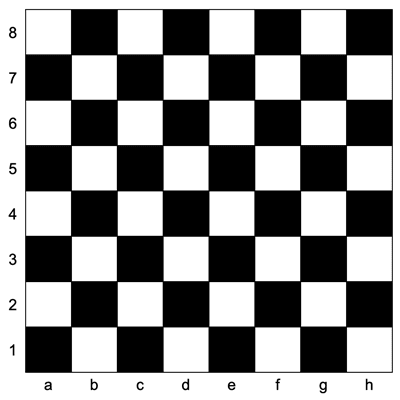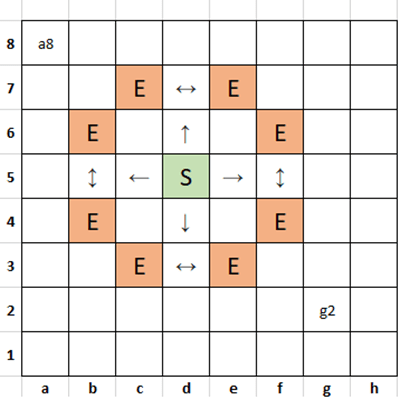The one about a chess board
Weekly Challenge 281
Sorry for being MIA over the last few weeks. I've moved house and a new job, so haven't had a chance to partake in the challenges over this time.
Each week Mohammad S. Anwar sends out The Weekly Challenge, a chance for all of us to come up with solutions to two weekly tasks. My solutions are written in Python first, and then converted to Perl. It's a great way for us all to practice some coding.
Challenge, My solutions
Task 1: Check Color
Task
You are given coordinates, a string that represents the coordinates of a square of the chessboard as shown below:

Write a script to return true if the square is light, and false if the square is dark.
My solution
This is relatively straight forward. The first thing I do is check that the provided position is valid (first character is a-h and the second character is between 1 and 8).
I then check if the first letter is a, c, e or g and the number is even, or the first letter is b, d, f or h and the number is odd, return true. Otherwise return false.
def check_color(coords: str) -> bool:
if not re.search('^[a-h][1-8]$', coords):
raise ValueError('Not a valid chess coordinate!')
if coords[0] in ('a', 'c', 'e', 'g') and int(coords[1]) % 2 == 0:
return True
if coords[0] in ('b', 'd', 'f', 'h') and int(coords[1]) % 2 == 1:
return True
return False
Examples
$ ./ch-1.py d3 true $ ./ch-1.py g5 false $ ./ch-1.py e6 true
Task 2: Knight’s Move
Task
A Knight in chess can move from its current position to any square two rows or columns plus one column or row away. So in the diagram below, if it starts a S, it can move to any of the squares marked E.

Write a script which takes a starting position and an ending position and calculates the least number of moves required.
My solution
This one is more detailed. I start with the follow variables:
- deltas is a tuples of lists (array of arrays in Perl) with the eight ways the knight can move from its current position.
- target is the cell that we want to reach. For this I convert the first letter to a number from one to 8. It's stored as a tuple, the first value is the column and the second value is the row.
- moves is the number of moves made and starts at one.
- seen is a list of cells we have already visited.
- coords is a list of current positions of a knight. It starts with the starting coordinate.
def knights_move(start_coord: str, end_coord: str) -> int:
for coord in (start_coord, end_coord):
if not re.search('^[a-h][1-8]$', coord):
raise ValueError(
f'The position {coord} is not a valid chess coordinate!')
deltas = ([2, 1], [2, -1], [-2, 1], [-2, -1],
[1, 2], [1, -2], [-1, 2], [-1, -2])
coords = [convert_coord_to_list(start_coord)]
target = convert_coord_to_list(end_coord)
moves = 1
seen = []
I then have a double loop of the current coords list and the deltas list. A set a variable new_pos that represents the new coordinates for the knight. If this leads to a position outside the board or a coordinate we've already been to, I skip it. If it lands on the target, I return the moves value.
After the loop, I reset the coords list to the coordinates collected through the iterations, and increment the moves value by one. This continues until we hit the target coordinate.
while True:
new_coords = []
for coord in coords:
for delta in deltas:
new_pos = (coord[0] delta[0], coord[1] delta[1])
if not 0
Examples
$ ./ch-2.py g2 a8
4
$ ./ch-2.py g2 h2
3
-
 How Can I Execute Multiple SQL Statements in a Single Query Using Node-MySQL?Multi-Statement Query Support in Node-MySQLIn Node.js, the question arises when executing multiple SQL statements in a single query using the node-mys...Programming Posted on 2025-04-16
How Can I Execute Multiple SQL Statements in a Single Query Using Node-MySQL?Multi-Statement Query Support in Node-MySQLIn Node.js, the question arises when executing multiple SQL statements in a single query using the node-mys...Programming Posted on 2025-04-16 -
 How Can I Efficiently Create Dictionaries Using Python Comprehension?Python Dictionary ComprehensionIn Python, dictionary comprehensions offer a concise way to generate new dictionaries. While they are similar to list c...Programming Posted on 2025-04-16
How Can I Efficiently Create Dictionaries Using Python Comprehension?Python Dictionary ComprehensionIn Python, dictionary comprehensions offer a concise way to generate new dictionaries. While they are similar to list c...Programming Posted on 2025-04-16 -
 The timing of using $.data() and $.attr() in jQueryjQuery Data vs Attr: Understanding the DifferencesIn jQuery, both $.data and $.attr are used to manipulate attributes in DOM elements. However, they s...Programming Posted on 2025-04-16
The timing of using $.data() and $.attr() in jQueryjQuery Data vs Attr: Understanding the DifferencesIn jQuery, both $.data and $.attr are used to manipulate attributes in DOM elements. However, they s...Programming Posted on 2025-04-16 -
 Why do Lambda expressions require "final" or "valid final" variables in Java?Lambda Expressions Require "Final" or "Effectively Final" VariablesThe error message "Variable used in lambda expression shou...Programming Posted on 2025-04-16
Why do Lambda expressions require "final" or "valid final" variables in Java?Lambda Expressions Require "Final" or "Effectively Final" VariablesThe error message "Variable used in lambda expression shou...Programming Posted on 2025-04-16 -
 How to Fix \"mysql_config not found\" Error When Installing MySQL-python on Ubuntu/Linux?MySQL-python Installation Error: "mysql_config not found"Attempting to install MySQL-python on Ubuntu/Linux Box may encounter an error messa...Programming Posted on 2025-04-16
How to Fix \"mysql_config not found\" Error When Installing MySQL-python on Ubuntu/Linux?MySQL-python Installation Error: "mysql_config not found"Attempting to install MySQL-python on Ubuntu/Linux Box may encounter an error messa...Programming Posted on 2025-04-16 -
 How Can You Define Variables in Laravel Blade Templates Elegantly?Defining Variables in Laravel Blade Templates with EleganceUnderstanding how to assign variables in Blade templates is crucial for storing data for la...Programming Posted on 2025-04-16
How Can You Define Variables in Laravel Blade Templates Elegantly?Defining Variables in Laravel Blade Templates with EleganceUnderstanding how to assign variables in Blade templates is crucial for storing data for la...Programming Posted on 2025-04-16 -
 How to efficiently repeat string characters for indentation in C#?Repeating a String for IndentationWhen indenting a string based on an item's depth, it's convenient to have an efficient way to return a strin...Programming Posted on 2025-04-16
How to efficiently repeat string characters for indentation in C#?Repeating a String for IndentationWhen indenting a string based on an item's depth, it's convenient to have an efficient way to return a strin...Programming Posted on 2025-04-16 -
 How to Correctly Use LIKE Queries with PDO Parameters?Using LIKE Queries in PDOWhen trying to implement LIKE queries in PDO, you may encounter issues like the one described in the query below:$query = &qu...Programming Posted on 2025-04-16
How to Correctly Use LIKE Queries with PDO Parameters?Using LIKE Queries in PDOWhen trying to implement LIKE queries in PDO, you may encounter issues like the one described in the query below:$query = &qu...Programming Posted on 2025-04-16 -
 Can You Use CSS to Color Console Output in Chrome and Firefox?Displaying Colors in JavaScript ConsoleIs it possible to use Chrome's console to display colored text, such as red for errors, orange for warnings...Programming Posted on 2025-04-16
Can You Use CSS to Color Console Output in Chrome and Firefox?Displaying Colors in JavaScript ConsoleIs it possible to use Chrome's console to display colored text, such as red for errors, orange for warnings...Programming Posted on 2025-04-16 -
 Effective checking method for Java strings that are non-empty and non-nullChecking if a String is Not Null and Not EmptyTo determine if a string is not null and not empty, Java provides various methods.Option 1: isEmpty()For...Programming Posted on 2025-04-16
Effective checking method for Java strings that are non-empty and non-nullChecking if a String is Not Null and Not EmptyTo determine if a string is not null and not empty, Java provides various methods.Option 1: isEmpty()For...Programming Posted on 2025-04-16 -
 How to Combine Data from Three MySQL Tables into a New Table?mySQL: Creating a New Table from Data and Columns of Three TablesQuestion:How can I create a new table that combines selected data from three existing...Programming Posted on 2025-04-16
How to Combine Data from Three MySQL Tables into a New Table?mySQL: Creating a New Table from Data and Columns of Three TablesQuestion:How can I create a new table that combines selected data from three existing...Programming Posted on 2025-04-16 -
 How to effectively modify the CSS attribute of the ":after" pseudo-element using jQuery?Understanding the Limitations of Pseudo-Elements in jQuery: Accessing the ":after" SelectorIn web development, pseudo-elements like ":a...Programming Posted on 2025-04-16
How to effectively modify the CSS attribute of the ":after" pseudo-element using jQuery?Understanding the Limitations of Pseudo-Elements in jQuery: Accessing the ":after" SelectorIn web development, pseudo-elements like ":a...Programming Posted on 2025-04-16 -
 When does a Go web application close the database connection?Managing Database Connections in Go Web ApplicationsIn simple Go web applications that utilize databases like PostgreSQL, the timing of database conne...Programming Posted on 2025-04-16
When does a Go web application close the database connection?Managing Database Connections in Go Web ApplicationsIn simple Go web applications that utilize databases like PostgreSQL, the timing of database conne...Programming Posted on 2025-04-16 -
 How does JTextField limit integer input only?Confining JTextField Input to IntegersRestricting user input to positive integers in a JTextField control has been a common issue in programming. Whil...Programming Posted on 2025-04-16
How does JTextField limit integer input only?Confining JTextField Input to IntegersRestricting user input to positive integers in a JTextField control has been a common issue in programming. Whil...Programming Posted on 2025-04-16 -
 How Can I Maintain Custom JTable Cell Rendering After Cell Editing?Maintaining JTable Cell Rendering After Cell EditIn a JTable, implementing custom cell rendering and editing capabilities can enhance the user experie...Programming Posted on 2025-04-16
How Can I Maintain Custom JTable Cell Rendering After Cell Editing?Maintaining JTable Cell Rendering After Cell EditIn a JTable, implementing custom cell rendering and editing capabilities can enhance the user experie...Programming Posted on 2025-04-16
Study Chinese
- 1 How do you say "walk" in Chinese? 走路 Chinese pronunciation, 走路 Chinese learning
- 2 How do you say "take a plane" in Chinese? 坐飞机 Chinese pronunciation, 坐飞机 Chinese learning
- 3 How do you say "take a train" in Chinese? 坐火车 Chinese pronunciation, 坐火车 Chinese learning
- 4 How do you say "take a bus" in Chinese? 坐车 Chinese pronunciation, 坐车 Chinese learning
- 5 How to say drive in Chinese? 开车 Chinese pronunciation, 开车 Chinese learning
- 6 How do you say swimming in Chinese? 游泳 Chinese pronunciation, 游泳 Chinese learning
- 7 How do you say ride a bicycle in Chinese? 骑自行车 Chinese pronunciation, 骑自行车 Chinese learning
- 8 How do you say hello in Chinese? 你好Chinese pronunciation, 你好Chinese learning
- 9 How do you say thank you in Chinese? 谢谢Chinese pronunciation, 谢谢Chinese learning
- 10 How to say goodbye in Chinese? 再见Chinese pronunciation, 再见Chinese learning

























